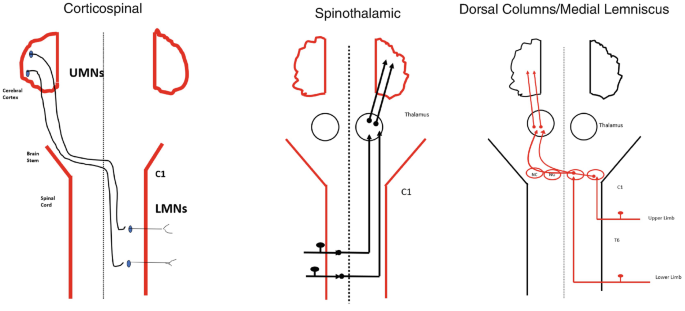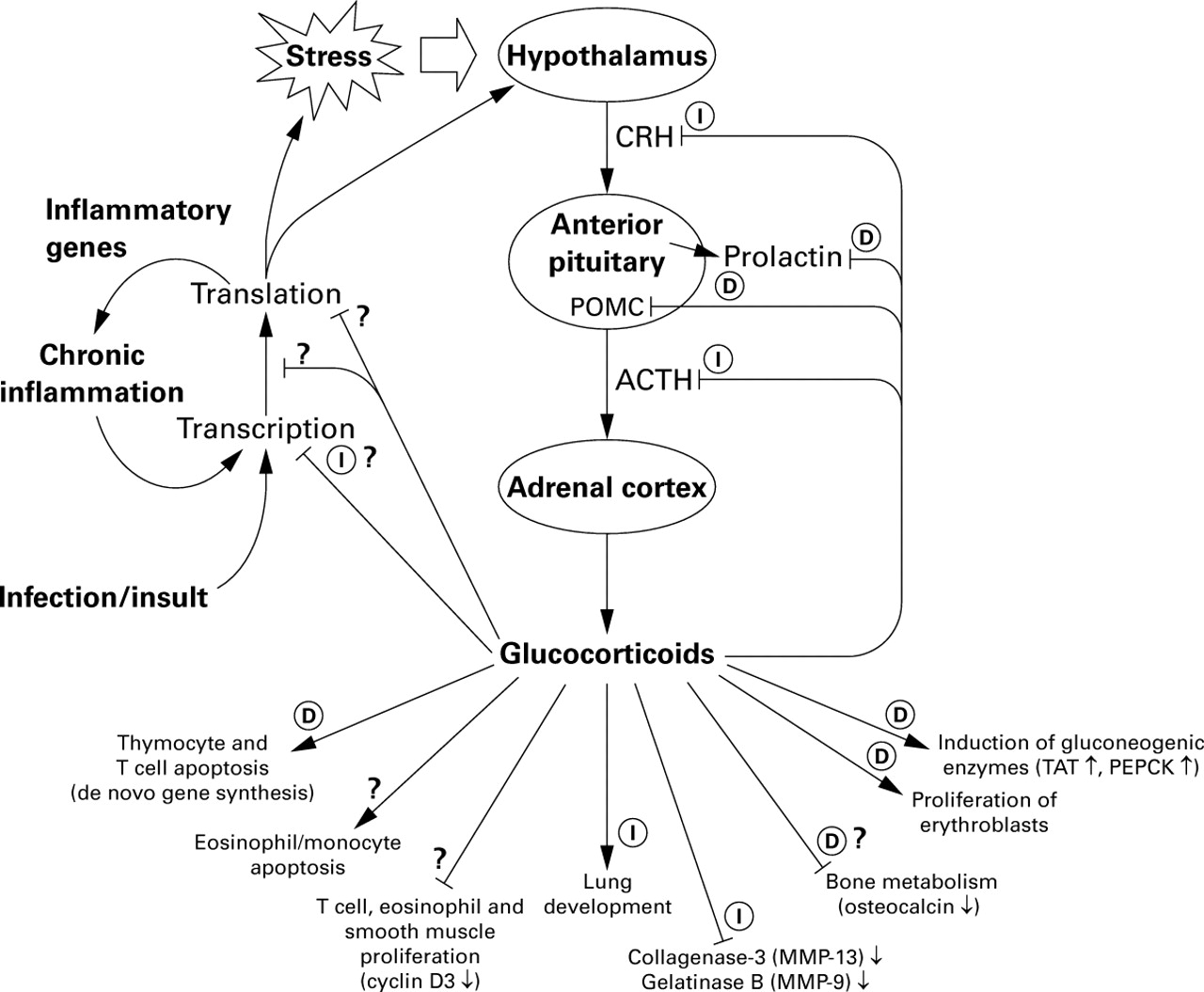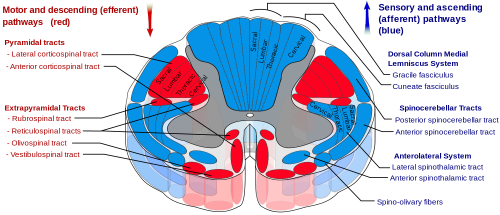What makes up the cerebral hemisphere
cerebral cortex, basal nuclei , hypocampus and the amygdala
Discuss the physiological effects of growth hormone (GH) in the body and its regulation. Mention the clinical manifestations of hypo- and hypersecretion of GH.
Growth hormone (GH) plays a critical role in growth, metabolism, and maintenance of body composition. It stimulates protein synthesis, promotes linear growth in children, and maintains muscle mass and bone density in adults. GH also enhances lipolysis and decreases glucose uptake, leading to increased blood glucose levels.
GH secretion is regulated by the hypothalamus and pituitary gland. Growth hormone-releasing hormone (GHRH) from the hypothalamus stimulates GH release from the anterior pituitary, while somatostatin inhibits its secretion.
Hyposecretion of GH during childhood results in growth retardation and short stature, known as growth hormone deficiency. On the other hand, hypersecretion of GH, often due to a pituitary adenoma, leads to gigantism if it occurs before epiphyseal plate closure in children, and acromegaly, characterized by enlarged hands, feet, and facial features, in adults.
What is the first-line drug in thyroid replacement therapy for hypothyroidism?
Levothyroxine
The drug therapy for hypothyroidism is replacement with oral thyroxine, using the laevo isomer, levothyroxine. Levothyroxine is in fact a form of prodrug which is converted into triiodothyronine T3 within peripheral cells of the body which carries out its effect. There is no T4 receptor as such.
What are the three main spinal tracts and give a short description of what each does
Spinothalamic - temperature, crude touch, and pressure. It is responsible for our quick withdrawal reaction to a painful stimulus such as touching the stove burner.
DCML - sensory modalities of fine touch (tactile sensation), vibration and proprioception.
Corticospinal Tract - The major neuronal pathway providing voluntary motor function. This tract connects the cortex to the spinal cord to enable movement of the distal extremities.

Neisseria meningitidis is often referred to as what?
Meningococcal meningitis
Describe the functional organization of the cerebral cortex, highlighting its major lobes and their associated functions. Provide an example of a specific cortical area and its function.
The cerebral cortex is divided into four major lobes: the frontal, parietal, temporal, and occipital lobes. Each lobe is associated with specific functions. The frontal lobe is involved in executive functions, motor control, and higher cognitive processes such as planning and decision-making. The parietal lobe processes sensory information, spatial awareness, and attention. The temporal lobe plays a key role in auditory processing, language comprehension, and memory consolidation. The occipital lobe primarily handles visual processing.

Describe the hormonal regulation of blood glucose levels in the body, including the roles of insulin and glucagon. Explain how dysregulation of this system leads to diabetes mellitus.
When blood glucose levels rise, pancreatic beta cells release insulin, which promotes glucose uptake by cells, storage of glucose as glycogen in the liver and muscle, and inhibits gluconeogenesis and glycogenolysis. Conversely, when blood glucose levels drop, pancreatic alpha cells release glucagon, which stimulates glycogen breakdown in the liver and muscle, gluconeogenesis, and release of glucose into the bloodstream.
In diabetes mellitus, there is either insufficient insulin production (Type 1 diabetes) or resistance to insulin action (Type 2 diabetes). In both cases, blood glucose levels become chronically elevated, leading to hyperglycemia. This can result in long-term complications such as cardiovascular disease, neuropathy, nephropathy, and retinopathy.
Patient presents with weight loss, heat intolerance, an activated cardiovascular system and exophthalmos, bulging eyes due to the deposition of abnormal connective tissue in the orbit of the eye. What condition is this patient presenting with?

Hyperthyroidism
Primary hyperthyroidism in the thyroid will stimulate a negative inhibitory feedback on the anterior pituitary decreasing TSH release. If the effect is secondary, TSH will be elevated. Unlike in hypothyroidism, the target for drug effect to treat hyperthyroidism is the thyroid gland itself
A patient complains to his doctor about a loss of taste. The doctor takes a history of the patient and notes no recent infections. However, the patient mentions being able to taste normally when only using the tip of his tongue. An example he gave was when he licks ice cream.
What cranial nerve is affected in this scenario?
Glossopharyngeal n. Loss of taste (posterior 1/3rd of the tongue) - CN IX
This is because the patient was able to taste his ice cream when licking it, which indicates that the anterior two-thirds of his tongue can sense taste normally. Therefore, this must mean that the loss of taste during eating originates from the loss of innervation in the posterior third of the tongue.
What immunoglobulin in found in colostrum and breastmilk and is this a form of passive or active immunization?
IgA, breastfeeding is a form of passive immunization because the antibody produced in another host.
Explain the role of the basal ganglia in motor control and movement disorders. Name two major nuclei within the basal ganglia and describe their functions.
The basal ganglia play a crucial role in motor control by modulating movement initiation, execution, and inhibition.
Two major nuclei within the basal ganglia are the substantia nigra and the striatum. The substantia nigra, specifically the pars compacta, produces dopamine, which is essential for coordinating movement and reward-related behaviors. The loss of dopaminergic neurons in this region is associated with Parkinson's disease.
The striatum consists of the caudate nucleus and the putamen, which receive inputs from various cortical regions and modulate motor output through the thalamus. Dysfunction in the striatum is implicated in conditions like Huntington's disease and Tourette syndrome, characterized by involuntary movements and tics.
The HbA1c test is a standard test used to check for type 2 diabetes; why is it more widely used?
a) More accurate and reliable results
b) Observe glucose levels over 3 months
c) Takes into account fluctuating glucose levels across the day
d) Easy to test and administer
2. Observe glucose level over 3 months
Following a case of fatigue and coldness, a 25-year-old man was rushed to hospital to be treated. Following lab tests, it was discovered they had undiscovered hypothyroidism. But prior to oral medication being administered the patient enters shock, what medication would you administer to the patient to aid their hypothyroidism.
Liothyronine (IV form of levothyroxine)
Which of the cranial nerves carry parasympathetic fibres? Can you name 1 function for each one?
Cranial nerves carrying parasympathetic fibres
X IX VII III (1973)
III (oculomotor) Pupillary constriction and accommodation
VII (facial) Lacrimal gland, submandibular and sublingual glands
IX (glossopharyngeal)Parotid
X (vagus)Heart and abdominal viscera

 This is a CT of the brain and below it is a close up picture, what artery is #7 pointing to? *hint: this is your circle of Willis
This is a CT of the brain and below it is a close up picture, what artery is #7 pointing to? *hint: this is your circle of Willis
 Basillar
Basillar
What is the most common artery that can get blocked + why?
middle cerebral a. = has no collateral circulation so blockages may prevent blood from reaching a part of the brain completely
An healthy affluent Irish 25-year-old, woman comes into your clinic with nausea and tiredness claimed to be linked to her current third-trimester pregnancy, after lab tests were done she was discovered to have diabetes-like symptoms. Past medical history shows cases of heart conditions that were treated, a family history of hypertension and a prior appointment with a food specialist regarding dietary intake changes.
What is most likely the cause of her symptoms?
Gestational Diabetes which is high blood glucose levels during pregancy without anyb diabetes and usually is in the last trimester, alleged to be due to insulin resistance. Some risk factors are polycystic ovary, BMI of over 30 and non-caucasian descent.
Anterior pituitary hormones are the central component of a 3 step pathway, what is that three-step pathway for the thyroid system?
Thyrotrophin-releasing hormone (TRH) releases thyroid stimulating hormone (TSH) from the anterior pituitary, which in turn releases thyroxine (T4) from the thyroid gland.
The process beings in the hypothalamus which secretes (TRH) in response to low levels of T3 and T4. TRH then travels to the anterior pituitary gland. The anterior pituitary gland responds to TRH by release TSH into the blood stream. TSH is a key regulator of thyroid function and acts on the gland itself. TSH then goes to the thyroid gland and binds to receptors on the surface of thyroid follicular cells, stimulating the synthesis of T3 and T4. Once T3 and T4 enter the bloodstream it does a negative feedback on the hypothalamus and anterior pituitary inhibiting further release of TRH and TSH.
How can the cerebrospinal fluid enter the brain parenchyma + what compartments does it enter once its in the brain parenhcyma?
The CSF can cross the ependyma barrier - CSF can flow in either direction. Flows due to conc and pressure gradient. Once it crosses the ependyma, it enteres the brain parenchyma (in the brain) and enters the extracellular space into the interstitual fluid. It can then pass into the intracellular space into the intracellular fluid.
Which type of vaccine are considered to be T cell–independent antigens? *hint they can be given as conjugate vaccines
a) Live attenuated
b) Polysaccharide
c) Toxoid
d) Inactivated (killed)
e) Nucleic Acid (DNA/RNA)
Polysaccharide vaccines: Polysaccharide antigens can be given with an adjuvant. They can also be conjugated vaccines that use a polysaccharide linked to a protein. To generate maximal immune response, including isotype switching (IgG), somatic hypermutation and memory formation, vaccines are linked to a carrier protein (“conjugate” vaccine)
Why are watershed zones more prone to ischaemic strokes?
Because healthy tissue continues to extract what it needs from the blood flowing by, leaving little or no oxygen nutrients and blood for the tissue in watershed zones
What are the antibodies detectable in Type 1 diabetes before the symptoms show?
Generally antibodies first to insulin & GAD65, later IA-2, IA-2β and ZnT8
Explain the mechanism of action and therapeutic uses of glucocorticoids, highlighting their anti-inflammatory properties. Discuss potential adverse effects associated with long-term glucocorticoid therapy.
MOA: Glucocorticoid medications exert their effects primarily by binding to glucocorticoid receptors, which are located within the cytoplasm of target cells. The glucocorticoid-receptor complex undergoes conformational changes upon binding, leading to its translocation into the cell nucleus. Inside the nucleus, the complex acts as a transcription factor, modulating the expression of specific genes by binding to glucocorticoid response elements (GREs) within the promoter regions of target genes.
Glucocorticoids are commonly used for their potent anti-inflammatory and immunosuppressive properties, making them effective in treating conditions such as asthma, rheumatoid arthritis, and inflammatory bowel disease.
Side effects: Long-term use of glucocorticoids can lead to numerous adverse effects, including osteoporosis, hyperglycemia, hypertension, weight gain, immunosuppression, and mood disturbances.

A 40-year-old man arrives at the clinic after episodes of dizziness for 2 weeks. He reports additional symptoms like unilateral hearing loss, tinnitus and double vision. CT Scans of the pons reveal an underlying pathology linked to cranial nerve 8.
What condition is the patient affected with and where exactly is it present in?
Acoustic neuroma (vestibular schwannoma) at the cerebellopontine angle
A 48-year-old female is known to suffer from B12 deficiency. She subsequently started to experience symptoms of subacute combined degeneration of the spinal cord affecting her dorsal columns. What modes of sensation will have been affected?
a) Light touch, fast pain and vibration
b) Proprioception, temperature and vibration
c) Light touch, vibration and proprioception
d) Fast pain, light touch and temperature
e) Temperature, fast pain, and proprioception
Light touch, vibration and proprioception
Subacute combined degeneration is the classical metabolic disorder of the spinal cord - it is due to vitamin B12 deficiency. It can also be caused by folate deficiency. The posterior columns and corticospinal tracts are specifically damaged, but the clinical picture is complicated by the early development of coexistent peripheral nerve damage.
The dorsal columns conduct light touch, vibration and proprioception.
